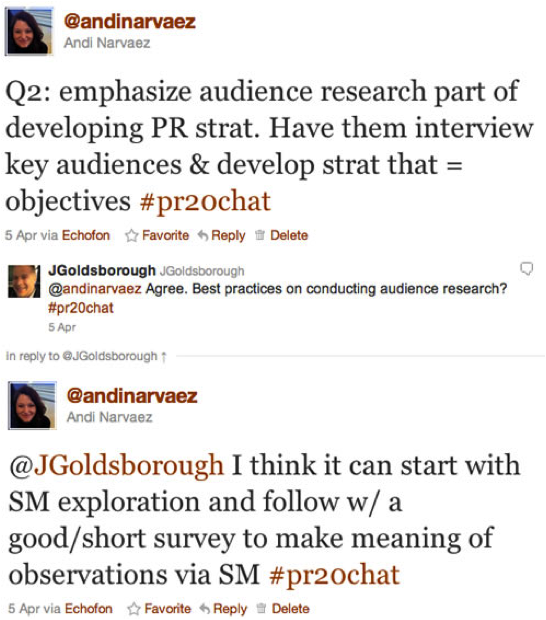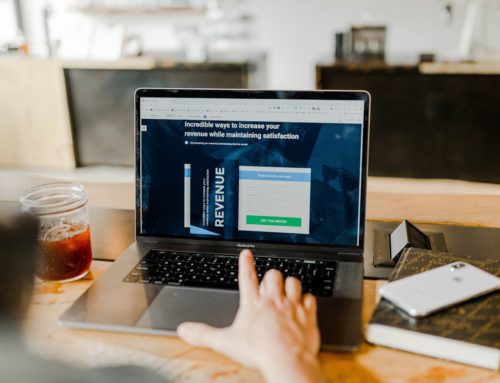During last week’s #pr20chat, Justin Goldsborough asked how PR professionals can best identify and cater to the needs of their target audience.
My response was something only a current public relations graduate student, fresh out of taking her comprehensive written and oral examinations, and appropriately trained in methods by her “We mean business when we say research” university would respond:
The response led to a comment by Justin, who shared that the practice of conducting surveys is not one that PR professionals employ as frequently as they should.
After all, if the public is at the heart of public relations, why wouldn’t we ask them how they feel about certain issues that involve our organizations, clients, industry, and even current events that directly or indirectly affect us and them?
The problem with surveying is that it, allegedly, takes too long.
But I would argue that if you are clear about what your organization’s goals and objectives are, then you know exactly what you are looking for, and developing a survey with appropriate questions shouldn’t take as long as you might think.
Then there is matter of tools.
In this case, a simple Google Form can go a long way for a grand total of zero dollars.
And in terms of distribution, an email to subscribers, a tweet, Facebook post, LinkedIn update, and word-of-mouth are simple means to secure a good response rate.
Additionally, we know that we can easily reach out to friends, followers, and peers for help in spreading the word.
Throughout graduate school, I have conducted in-depth interviews for all of my investigations.
These require that I:
- turn in an application and research proposal to the University’s Institutional Review Board (IRB),
- wait two to three weeks (our IRB is über-efficient; other institutions don’t get back to you for months), and
- make sure I obtain signed consent from my participants before conducting my interviews.
Sound like a pain in the butt?
It is.
But interviews, among other qualitative methods like focus groups, are crucial in the discovery process that ultimately leads to developing a meaningful survey that can be distributed to a larger population and lead to valuable results.
The good news for PR professionals who want to do a little discovery before diving into a survey is that there is no IRB to go through.
We are the masters of our own ethical and procedural checks (no pressure).
While interviews and focus groups may still be used, if you are actively engaging your customers via social media channels, and monitoring those conversations””even if just informally””you are already familiar with the dialogue that surrounds your organization and you can develop a survey that reflects some of the feedback within that ecosystem.
LinkedIn Answers are often used by professionals searching for answers to their burning questions.
Quora has popularized the concept of asking open-ended questions and getting rich feedback from peers and others in our industry or who share our interests.
And, now, even good ol’ Facebook has added Questions to its list of features in order to help us get feedback from our network of friends.
The idea of polling and surveying is catching on (again).
If there is one thing PR professionals have demonstrated we are good at, it’s our ability to adapt and adopt emerging concepts and technologies for the purpose of serving our customers better.
Let’s reach into our toolbox and pull surveys back out, to make sure the decisions we implement and the communications programs we develop are based on more educated findings rather than on historical processes or wild guesses.
Image: PNNL – Pacific Northwest National Laboratory via Flickr, CC 2.0
 Andi Narvaez is a public relations (old and new school) and social media professional. She currently serves on the advisory boards of Social Media Club DC and Social Media Club Education Connection. She works for Citizen Effect, a philanthropy start-up dedicated to providing citizens with the tools and support they need to work directly with communities in need around the world. She is originally from Quito, Ecuador, but moved to Washington, D.C., in 2009 to pursue a master’s degree in Public Relations at University of Maryland. Check out her blog.
Andi Narvaez is a public relations (old and new school) and social media professional. She currently serves on the advisory boards of Social Media Club DC and Social Media Club Education Connection. She works for Citizen Effect, a philanthropy start-up dedicated to providing citizens with the tools and support they need to work directly with communities in need around the world. She is originally from Quito, Ecuador, but moved to Washington, D.C., in 2009 to pursue a master’s degree in Public Relations at University of Maryland. Check out her blog.





![[EVENT]: PR Hacks for Small Biz (online)](https://shonaliburke.com/wp-content/uploads/2021/06/FB-Ad-1200x800-01-01-01-Copy-500x383.jpeg)





[…] Read the full post on Shonali Burke’s Waxing Unlyrical […]
@JGoldsborough “Measurati”? I love that! Where’s my crown? ;p Seriously, though, you’re very kind.
@jaykeith@andinarvaez
@andinarvaez this is a great post. I agree completely that surveys are a tool that we all should be using: marketing, PR, analytics people, social media, etc. There are always questions to ask and there are always pressing answers that the company needs. And while surveys can be a bit difficult to get off the ground and up and running, the truth is once you do, the benefits you reap are enormous. I personally run a survey group at vistaprint that has given us tremendous information around the micro business community (our core customer group) as well as purchasing behavior, social media usage, company attitudes, etc. And now that the group has been established, all you have to do is figure out what to ask, how often and how best to reward/engage those people who are taking the time to fill them out.
The one caveat that I think is important to note is that if you’re going to share the results of any survey externally (or even internally) you need to be very explicit about the numbers, the sources, and how the survey was conducted. I think one of the problems with survey results we’ve seen in the recent past is that because everyone is keen to push out results, the methodology isn’t necessarily “100%” so to speak. Sometimes it’s a small sample and that isn’t explained, so the results are overblown as “givens” when in fact they probably aren’t. We all need to keep in mind that producing/pushing “good” research is important, not just asking questions getting answers without any thought to strategy and methodology. But we also need to make sure that context is always kept in mind with any results. Surveys are great, but they always tell one part of a much larger story.
[…] A: It’s always about measurable goals and objectives, isn’t it? A lot of the benefit of engagement takes place offline (93 percent of word of mouth happens away from a computer anyway) or is long-term. It’s hard for a CEO to invest millions or get behind results he can’t see. But executives understand business goals. Quite often, they’re the ones who created or signed off on them. So tie your campaigns back to those measurable objectives and show a correlation there, whether through intricate data from listening tools or primary research methods like surveys. […]
Thanks for the #pr20chat mention, andinavarez . I think you are right on that we can’t forget the value and insights a simple survey can provide — especially in a medium where listening is the heart and soul of what we are doing.
shonali and donbart are two measurati I respect who have remained advocates of surveying and primary research. And if you haven’t heard lulugrimm ‘s #BSPP case study and the role surveying played in it, make sure to check it out. Cheers.
[…] Read the full post on Shonali Burke’s Waxing Unlyrical […]